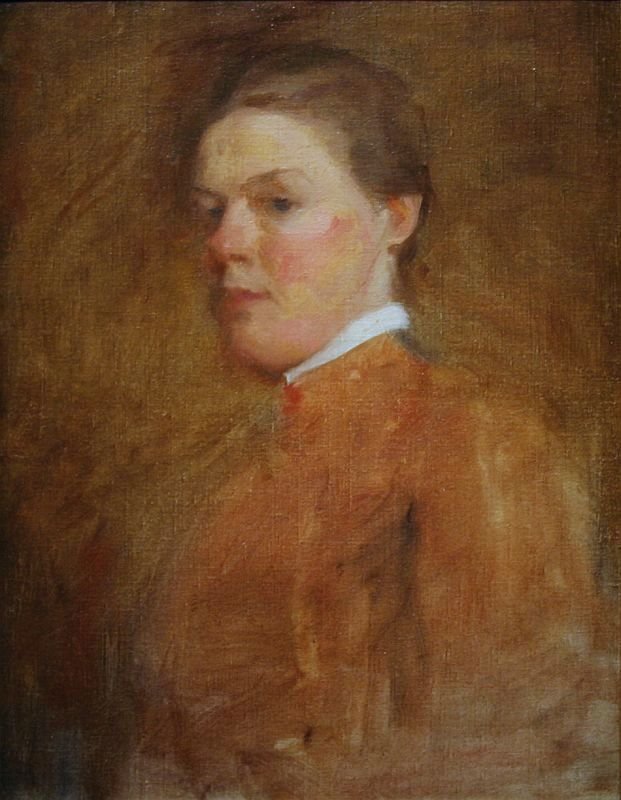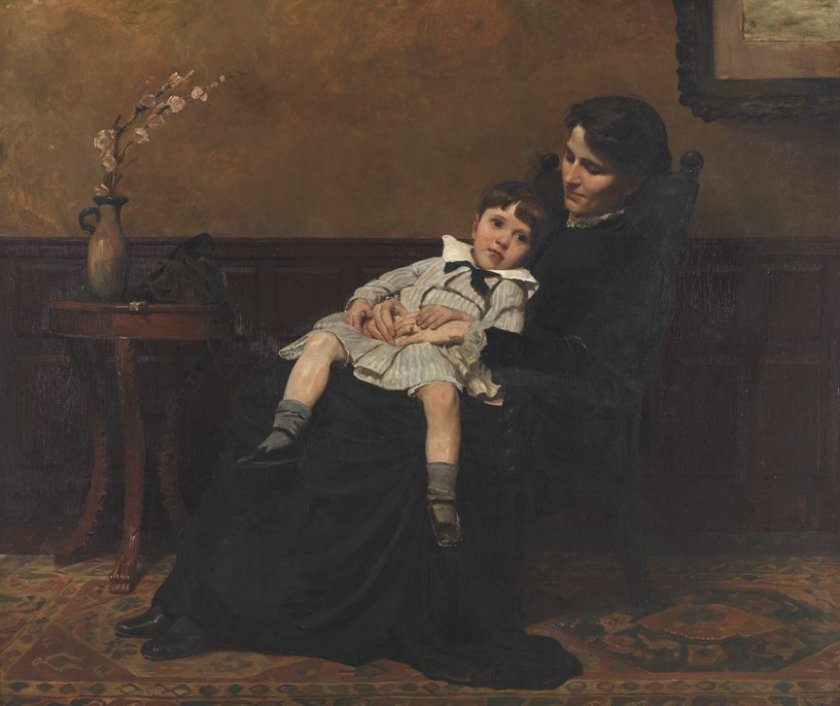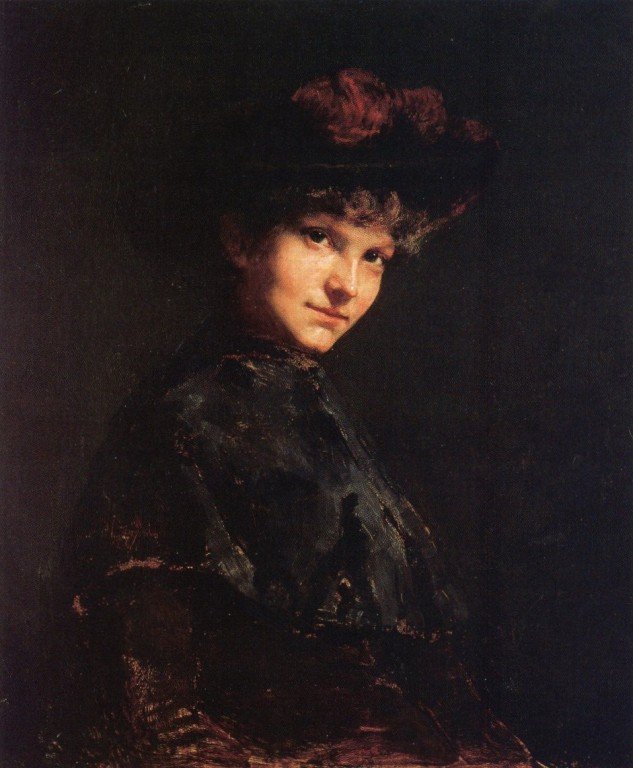
………….the year is 1881 and Cecilia Beaux had started to attend classes organised by a former schoolfriend and their work had been periodically critiqued by the painter William Sartain. These classes went on for two years but in 1883 Cecilia got her own studio on Chestnut Street, Philadelphia, and the class moved there where they did unsupervised life drawings. It was unsupervised as the visits by William Sartain had ended due to the long commute he had to make to get from New York to Philadelphia in order to examine and review the ladies’ work. At this time Cecilia was concentrating on her portraiture and as she wrote in her biography she even decided to try and have a work of hers included in an exhibition:
“…At this time, I did a study of a friend which resulted in my making my
first entrance into the doubtful field of the Exhibitions. It was well hung at the Pennsylvania Academy and was considerably noticed…”

It was whilst walking around her large and empty studio that Cecilia had the idea to paint a large portrait of two people in “landscape” format. Unbeknown to her at the time, it was to be one of her best-known works. Her idea was to paint a portrait of a mother and her small child. Not just any mother and child but her sister Etta, who had married Henry Sturgiss Drinker in 1879, and her first-born child, Henry (Harry) Sandwith who was born a year later. In her autobiography, Background with Figures, she envisioned how the portrait would look:
“…The mother in black sat in a low chair, the brown-eyed boy of three almost reclining in her arms. He was to wear a short blue-and-white cotton garment, his bare legs trailing over his mother’s knees. Her head was bent over him, and his hands lay upon her very white ones, which were clasped around him. The whole picture was to be warm in tone and in an interior which did not exist, except in the mind of the designer…”
She had discussed the idea with William Sartain who probably came up with the French title for the proposed work, Les derniers jours d’enfance. (The last days of childhood). Now, all she had to do was persuade her sister Etta to agree to pose with her son for the painting and she foresaw problems, which she wrote about:
“…Poor Etta would have to take the boy to town, an hour’s trip in the horse-cars, climb eighty-four steps, and probably do this many times, with a rather uncertain result…”
However, all Cecilia’s worries came to nought as Etta was only too pleased to have her and her son depicted in a portrait. Cecilia embarked on this large painting (46 x 54 inches / 116 x 137cms) in 1883 and it took two years to complete. In the painting, we see Etta, sitting in an old steamer chair, dressed in a black frock with its various textures. Cecilia had decided to show just one of her sister’s arms in the painting and so she had made up one closely-fitting black satin sleeve with rich lace at the wrist. Although hard to detect in the picture, Cecilia had placed a canton crepe shawl, which belonged to her grandmother, around her sister’s knees, the garment exactly taking the lines of the skirt. The shawl had been dyed black and though it was delicate, had a rich hanging texture, which made it form-fitting.
Cecilia had staged the depiction meticulously bringing several family accoutrements into her studio. On the floor she had laid one of the Leavitt family’s best oriental rugs and Etta had lent her one of her in-law’s heirlooms, a small wooden table upon which she placed a flower-filled vase belonging to the Drinker family. The background is interesting. Cecilia went out and bought a short piece of panelling from a carpenter’s shop and dyed it so it looked like a piece of mahogany and it was so placed behind the sitters so as to look like a piece of wainscoting joining the wall and floor.
Cecilia remembered in her autobiography that the numerous sittings for this joint portrait went well:
“…My sister bore her part with her usual gallantry. The boy was extremely amused by the novelty of the scene in which he found himself. His mother’s lap was comfortable, his head leaned upon her breast and her voice was close to his ear, and in the rests, he enjoyed running out into the hall with me to get a distant view of the canvas through the open door…”
It is interesting to note that Etta was occasionally relieved of her seated pose by a young woman who occupied the studio next door, for she volunteered to help as a model and posed for the draped knees and feet !

Look carefully how Cecilia had her sister and nephew pose with their hands entwined on her lap at the centre of the composition making it the focal point. Harry’s darkened fingers of his left hand placed on top of the white hand of his mother. The painting was exhibited at the Pennsylvania Academy of Fine Arts annual exhibition in 1885 and was awarded the Mary Smith Prize for the best work by a local woman.

Two years later, in 1887, a girlfriend of Cecilia and a fellow painter, Margaret Lesley Bush-Brown, who had been studying art at the Académie Julian in Paris and was returning to France, suggested taking the painting to the Salon for examination by the exhibition jurists. Cecilia was taken aback by the offer but agreed and the Salon jurists accepted it and it was prominently displayed in the Paris Salon of 1887. Cecilia deemed this to be a great honour and marked the beginning of her artistic career. More importantly maybe, it also gave her a hankering to taste the delights of Paris which she believed to be the heart and soul of the art world.

Many people have commented on the likeness of the setting of Cecilia’s mother and child depiction to James McNeill Whistler’s Arrangement in Grey and Black: Portrait if the Artist’s Mother, which had been displayed at the 1881 Centennial Exhibition held in Philadelphia and probably had been seen by Cecilia, but she strongly denied that Whistler’s portrait of his mother had influenced her. The painting Les derniers jours d’enfance is now housed at the Pennsylvania Academy of the Fine Arts in Philadelphia.

Cecilia Beaux went on to paint many tender mother and child portraits which had become so popular. One example of this was her portrait, completed in 1902, entitled Mrs. Alexander Sedgwick and Daughter Christina. Five-year old Christina would, seventeen years later, marry the famous American writer and journalist, John Phillips Marquand who was famous for his Mr Moto spy stories.

Following the completion and success of The Last Days of Childhood Cecilia Beaux carried on with her portraiture. She captured the likenesses of many leading figures from the worlds of politics and the arts, as well as works featuring friends, neighbours, family and, through her connections with the church, she produced three commissioned portraits of ministers, two of whom came through her involvement with the Woodland Presbyterian Church. One such portrait was of the well-known and well-respected eighty-four-year-old Philadelphia Unitarian minister, Reverend Doctor William Henry Furness, which she completed in 1886. Friends of the minister, who had just retired, commissioned the portrait to commemorate all the work he had done for the ministry over a fifty-year period. When the work was briefly exhibited at the Earle galleries, prior to it being given over to the Unitarian Church in Philadelphia for a fee of $500, it was well received by both the public and the art critics. The art critic of the Philadelphia Evening Telegraph, wrote in the December 28th edition of the newspaper:
“…Miss Beaux has copied nature with faithful care, and has concurrently reproduced those suggestions of individuality and personality…. In this respect the portrait is marvellously life-like, and no one not coldly indifferent and insensible can study the work without being impressed by the attributes of benign, gracious, potent manliness it presents…”

Cecilia completed many portraits featuring Ethel Page, a Philadelphia socialite. Cecilia met Ethel Page in 1876. The 1884 portrait of Page with the sitter’s face brightly lit in contrast to the dark background was typical of was typical of Cecilia’s early style.
 The haunting facial expression of the sitter with her piercing stare makes for a beautiful study.
The haunting facial expression of the sitter with her piercing stare makes for a beautiful study.

Another portrait of Page completed in 1885 depicts the actress in her role as Uncompaniondine and this again won Cecilia the Mary Smith Prize at the Pennsylvania Academy for the second year in a row.

Cecilia Beaux completed a pastel portrait of Ethel Page in 1890. It is a much softer depiction which has a feeling of warmth and in a way, highlights the artist-sitter’s friendly relationship. The portrait of Ethel Page also exudes a sense of elegance and I am sure the finished painting pleased the sitter.
A new phase in Cecilia Beaux’s life came in January 1888 when she and her companion, her cousin May Whitlock boarded the SS Nordland bound for Paris……..
………………………..to be continued.
Besides various internet websites, most of the information for the blogs featuring Cecilia Beaux came from two books:
Background with Figures, the autobiography of Cecilia Beaux
Family Portrait by Catherine Drinker Bowen
and the e-book:
Out of the Background: Cecilia Beaux and the Art of Portraiture by Tara Leigh Tappert
The blog, American Girls Art Club In Paris. . . and Beyond, featuring Cecilia Beaux was also very informative and is a great blog, well worth visiting on a regular basis.:
https://americangirlsartclubinparis.com/tag/catherine-ann-drinker/
